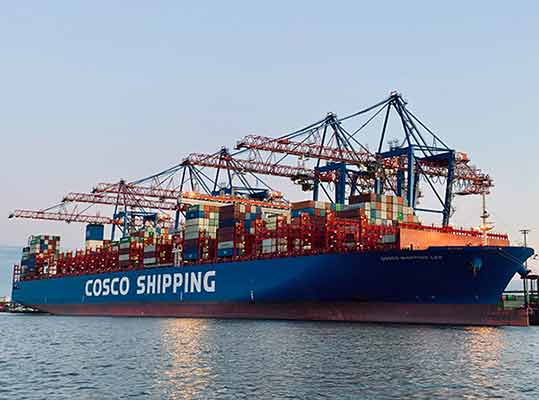Technology investments to improve global supply chain network transparency can lower operating costs and free up working capital.

By: Monica Truelsch, Senior Director of Supply Chain Management Strategy, Infor
The rising costs of freight, labor and materials markets have had a significant impact on company profit margins by way of the cost of goods and services (COGS). Even worse for business may be the uncertain availability of goods and components from overseas.
Lean manufacturing processes and their corollary, lean inventories, are feasible only with well-controlled and predictable supply lines. The pandemic has added a significant dose of unpredictability, and revealed just how little of their supply chain first-mile that companies can monitor, much less control. Technology investments to improve the transparency of global supply chain networks can not only lower operating costs and free up working capital, but also help improve and futureproof business operations.
When faced with cost increases — in freight, warehousing, labor and direct procurement — merchants inevitably pass some of those costs along to end customers to recover lost margins and profit. But passing costs through as higher prices has risks: What if competitors don’t do the same? What if customers balk?
Companies that thrive in these challenging economic environments are quick to re-assess, re-imagine and re-invent their supply chain operations. They look for ways to drive out waste and inefficiency, to automate low-value manual efforts, to streamline end-to-end processes instead of optimizing locally. The focus of continuous improvement can shift from cost reduction to cost containment, preparing companies with more agile and resilient performance to leap ahead of competitors once conditions begin to stabilize.
The past two years revealed just how under-invested most manufacturers were in first-mile supply chain technologies. Businesses discovered that their default supply chain visibility systems were based on daily manual efforts by countless employees, phoning and emailing suppliers, and then logging in to carrier and 3PL websites for shipment data. This hard-won information was then compiled and shared as spreadsheet reports, with all the significant data latency that such processes carry. Consequently, production planning struggled, and manufacturing lines shut down as increasingly unreliable lead times and extended transit times became the norm for inbound supply chains.
But companies that had already embraced transparency initiatives to improve first-mile operations could spot developing problems earlier. With ready access to dynamic order status with suppliers and the ability to track shipments in-transit across oceans, they had more options to mitigate their impacts. First-mile transparency — rather than simple transportation visibility — gained through supply chain network platforms opened more collaboration and innovation opportunities to procurement and logistics teams. Sharing order and demand forecasts regularly with suppliers, key carriers and 3PLs allowed those partners to plan and assure capacity more effectively. Transparency with trading partners and service providers created win-win scenarios that nimble manufacturers used to advance digitalization further, as all parties benefited from the more efficient use of increasingly scarce supply chain resources.
While no technology could bring back 2019 freight rates, the ability to work around material and component delays and avoid manufacturing disruptions through earlier awareness helped to smooth out on-time in-full (OTIF) performance. Customers also enjoyed better order experiences than they got from less-resilient vendors. Today, supply chain transparency and global logistics solutions are automating and eliminating multi-enterprise complexities across the first mile, and often the middle and final miles as well. Increasingly deployed end-to-end, especially where manufacturers serve complex global markets, networked supply chain management solutions are driving out labor and operational costs, reducing wasted effort, improving staff satisfaction and decision support, feeding more agile manufacturing plans, and helping revive profitability and swift margin recovery.
As traditional supply chain silos begin to merge, historically linear processes are giving way to more adaptive and collaborative digital interactions. The new appreciation for transparency extends to corporate environmental, social, and governance (ESG) initiatives too, where suppliers and transportation providers can more easily work with their manufacturing customers toward shared sustainability goals.
Supply chain transparency offers more value than narrow visibility solutions by focusing on broader categories of transaction and information sharing, mutual benefits, and a common source of shared truth with trading partners. The next global event to impact supply chains may demand entirely new cooperation models to assure swift and successful responses.
Uncertainty is a great enemy for industrial firms, potentially more dangerous than risk. Lead times and transit times, peak seasons and procurement seasons are no longer fixed and predictable. In place of the three- or five-year plan, manufacturers are shifting to sense-and-respond operation styles, emphasizing agile response capabilities to volatile environments over perfect planning predictions.

Monica Truelsch is Senior Director of Supply Chain Management Strategy at Infor.
In this episode, I sat down with Beejan Giga, Director | Partner and Caleb Emerson, Senior Results Manager at Carpedia International. We discussed the insights behind their recent Industry Today article, “Thinking Three Moves Ahead” and together we explored how manufacturers can plan more strategically, align with their suppliers, and build the operational discipline needed to support intentional, sustainable growth. It was a conversation packed with practical perspectives on navigating a fast-changing industry landscape.